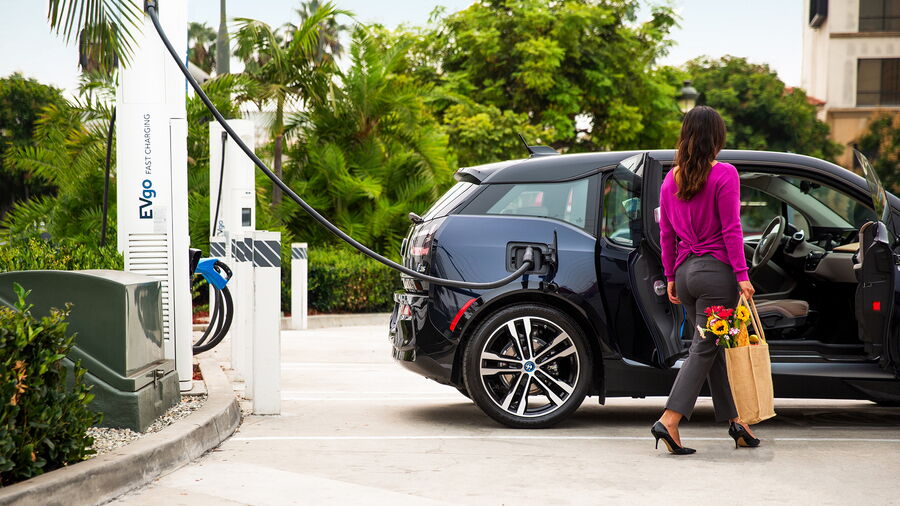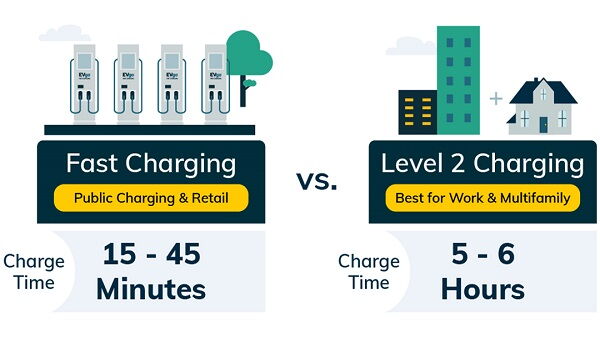Level 2 AC vs. DC Fast Charging: Which is the Best Fit for Your Business?
On this page
As the electric vehicle (EV) market continues to grow, businesses face a crucial decision: which EV charging solution aligns best with their operational needs and customer expectations? The choice often boils down to Level 2 AC charging or DC fast charging. Both options offer distinct advantages depending on the use case, installation requirements, and long-term business goals. Here's a detailed comparison to help you determine the best fit for your business.

Level 2 chargers typically add about 20-25 miles of range per hour, making them ideal for overnight charging or locations where customers and employees spend a few hours.
The infrastructure and operational costs of Level 2 chargers are significantly lower than DC fast chargers, making them an accessible choice for many businesses.
Level 2 stations can be installed in diverse settings, including private garages, public parking lots, and commercial properties, without the need for extensive electrical upgrades.
DC fast chargers (DCFC) deliver high-voltage direct current to the EV’s battery, bypassing the vehicle’s onboard charger to provide a rapid charge. These chargers are ideal for businesses prioritizing speed and catering to drivers on tight schedules.
DC fast chargers can provide up to 80% of a vehicle's battery capacity in as little as 20-30 minutes, depending on the vehicle and charger power rating (commonly 50kW to 350kW).
Their ability to quickly recharge vehicles makes DCFCs a preferred choice for highway rest stops, fuel stations, and other high-traffic locations.
While they deliver unmatched speed, the installation and maintenance costs for DC fast chargers are substantially higher due to the need for advanced electrical infrastructure and utility coordination.
Level 2 charging stations are versatile and cater to various business environments, offering tangible benefits for both property owners and users.
Providing Level 2 chargers at workplaces supports employees with EVs, allowing them to recharge while they work. This initiative demonstrates corporate sustainability efforts and enhances employee satisfaction. Additionally, offering EV charging at work can attract talent and showcase a commitment to green initiatives.
EV charging solutions in residential complexes are becoming a necessity, especially in regions with EV-friendly regulations. Installing Level 2 chargers not only attracts residents but also increases property value. They are a cost-effective way to meet requirements for EV-ready parking spaces in new developments.
Adding Level 2 chargers in public parking lots diversifies revenue streams and attracts EV drivers. Many customers prefer facilities with charging options, increasing foot traffic and loyalty.
Retailers, restaurants, malls, and event venues can use Level 2 charging stations to draw in customers. Shoppers who stay longer benefit from topping up their vehicles while enjoying their visit. Integrating these chargers with loyalty programs further boosts customer engagement and retention.
Businesses operating light-duty fleets find Level 2 chargers sufficient for their needs. Drivers can recharge their vehicles overnight, ensuring they’re ready for operations the next day. The lower cost of Level 2 infrastructure makes it an attractive choice for fleet managers.
DC fast chargers cater to businesses and industries where speed is crucial and high power is required for vehicle operations.
For businesses along highways, DC fast chargers serve as a significant draw for EV drivers. Customers can quickly recharge their vehicles while grabbing a snack or drink, increasing overall store traffic and revenue.
Electric buses and heavy-duty vehicles operated by cities require fast, efficient charging to remain in service throughout the day. DC fast chargers installed at key locations along fleet routes ensure minimal downtime and maximum operational efficiency.
Industries using electric forklifts, yard tractors, or other heavy-duty vehicles benefit from DC fast charging. Instead of rotating vehicles out for charging, fast chargers keep the entire fleet running continuously, maximizing productivity.
Installing and maintaining EV chargers varies significantly between Level 2 AC chargers and DC fast chargers. Businesses must weigh the costs and logistical complexities involved.
Installing Level 2 chargers is generally straightforward. These chargers require a 240-volt power supply, which is readily available in most commercial and residential properties. Installation costs are lower, making them a viable option for businesses with budget constraints or those just entering the EV charging space.
DCFC installation involves more extensive planning, including utility coordination, permitting, and significant construction. The upfront investment is higher due to the advanced electrical infrastructure required, including transformers and higher-capacity power lines.
Companies like EVgo offer solutions to streamline the installation process. As owner-operators, EVgo handles utility coordination, construction, and permitting. This approach not only removes the burden of installation costs from the business but also ensures ongoing maintenance for optimal charger performance. EVgo’s network management strategies maintain 98% uptime, ensuring reliability for EV drivers and enhancing customer satisfaction.

Level 2 chargers are more cost-effective in terms of installation and maintenance, while DC fast chargers require a larger investment but offer rapid charging capabilities.
Consider how long vehicles will be parked at your location. For short stops, DC fast charging is ideal. For longer stays, such as at workplaces or malls, Level 2 charging suffices.
Analyze your target audience. Highway travelers or heavy-duty fleet operators prefer fast charging. Residents, employees, and shoppers may favor Level 2 chargers for convenience and affordability.
DC fast chargers require more space and a robust power supply. Ensure your property can accommodate the necessary infrastructure before deciding.
Local building codes or green initiatives may influence your decision. For instance, certain areas may mandate a percentage of EV-ready parking spaces, making Level 2 chargers a more practical choice.
Both Level 2 AC and DC fast charging solutions have unique benefits tailored to specific business needs. Level 2 chargers are cost-effective, versatile, and ideal for locations where vehicles remain parked for extended periods. DC fast chargers, on the other hand, deliver unmatched speed and convenience, making them indispensable for high-traffic or time-sensitive applications.
Ultimately, the choice depends on your business model, customer needs, and budget. In many cases, a combination of Level 2 and DC fast charging stations provides the best of both worlds, offering flexibility to meet diverse charging demands. By aligning your charging infrastructure with your business goals, you can attract EV drivers, boost revenue, and contribute to a sustainable future.
Ultimately, the choice depends on your business model, customer needs, and budget. In many cases, a combination of Level 2 and DC fast charging stations provides the best of both worlds, offering flexibility to meet diverse charging demands. By aligning your charging infrastructure with your business goals, you can attract EV drivers, boost revenue, and contribute to a sustainable future.
